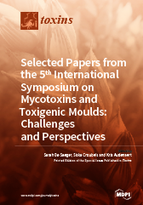Selected Papers from the 5th International Symposium on Mycotoxins and Toxigenic Moulds: Challenges and Perspectives
A special issue of Toxins (ISSN 2072-6651). This special issue belongs to the section "Mycotoxins".
Deadline for manuscript submissions: closed (31 August 2016) | Viewed by 77863
Special Issue Editors
2. Faculty of Science, University of Johannesburg, Johannesburg, South Africa
Interests: mycotoxins
Special Issues, Collections and Topics in MDPI journals
Interests: mycotoxins; toxicokinetics; toxicity; binders; modifiers; in vitro; in vivo; food production animals; porcine biomedical model for humans; bioanalysis; biomarkers; cytochrome P450; ABC transporters; impact on infectious diseases; veterinary drugs; pharmacokinetics; pharmacodynamics; PK/PD modeling; residues; food safety
Special Issues, Collections and Topics in MDPI journals
Interests: plant–pathogen interactions; biocontrol; endophytic fungi; green leaf volatiles (GLVs); biogenic volatile compounds (BVOCs); plant defense priming; plant hormones; phenomics; genome-editing in fungi; plant defense pathways; biodegradation of mycotoxins; mycotoxin prediction and modelling; bioassays to assess toxicity of trichothecenes and their derivatives
Special Issues, Collections and Topics in MDPI journals
Special Issue Information
Dear Colleagues,
The 5th International Symposium “Mycotoxins and Toxigenic Moulds: Challenges and Perspectives” will be held in Ghent, Belgium on May 11, 2016.
Mycotoxins—toxic fungal secondary metabolites—play a significant role in food and feed safety. They have shown to be the number one threat regarding chronic toxicity related to food and feed contaminants. Economic losses are due to effects on livestock productivity and to direct losses in crop yield and stored agricultural products. Legislative limits for a range of mycotoxins worldwide, as well as the presence of emerging mycotoxins result in an increased number of official controls deriving from national food safety plans. The challenges in mycotoxin and toxigenic mould research are still enormous due to the frequency, complexity and variability in occurrence.
The MYTOX association research platform MYTOX "Mycotoxins and Toxigenic Moulds" was established in 2007 and consists of more than 50 researchers from 12 research laboratories in the Ghent University Association. MYTOX deals with mycotoxin research in a multi-disciplinary way, based on four main units: (1) mycotoxins; (2) toxigenic fungi; (3) mycotoxins and animal health; and (4) mycotoxins and human health. In this way, MYTOX tackles the mycotoxin issue along the production chain from the field to the end consumer, within the ‘One Health’ concept.
We would like to welcome you at the 5th edition of the MYTOX International Symposium. The program includes oral and poster presentations related to fungal-related disease monitoring; mycotoxin analysis in food and feed, as well as in animal and human biological samples; prevention on the field; management strategies during food and feed storage and processing.
The Symposium welcomes participants from industry, government as well as academia. Only through multidisciplinary efforts and concerted actions, can further progress and solutions be expected for the mycotoxin problem.
This Special Issue aims to bring together active researchers to present their current work in mycotoxins and mycotoxigenic fungi.
For additional links to the Symposium which you may find useful, follow:
http://en.mytox.be/conferences/
Prof. Dr. Sarah De Saeger
Prof. Dr. Siska Croubels
Prof. Dr. Kris Audenaert
Guest Editors
Manuscript Submission Information
Manuscripts should be submitted online at www.mdpi.com by registering and logging in to this website. Once you are registered, click here to go to the submission form. Manuscripts can be submitted until the deadline. All submissions that pass pre-check are peer-reviewed. Accepted papers will be published continuously in the journal (as soon as accepted) and will be listed together on the special issue website. Research articles, review articles as well as short communications are invited. For planned papers, a title and short abstract (about 100 words) can be sent to the Editorial Office for announcement on this website.
Submitted manuscripts should not have been published previously, nor be under consideration for publication elsewhere (except conference proceedings papers). All manuscripts are thoroughly refereed through a double-blind peer-review process. A guide for authors and other relevant information for submission of manuscripts is available on the Instructions for Authors page. Toxins is an international peer-reviewed open access monthly journal published by MDPI.
Please visit the Instructions for Authors page before submitting a manuscript. The Article Processing Charge (APC) for publication in this open access journal is 2700 CHF (Swiss Francs). Submitted papers should be well formatted and use good English. Authors may use MDPI's English editing service prior to publication or during author revisions.
Keywords
- Mycotoxins
- Toxigenic fungi
- Food safety
- Feed safety
- Health
- Mycotoxin analysis
- Plant pathogens









